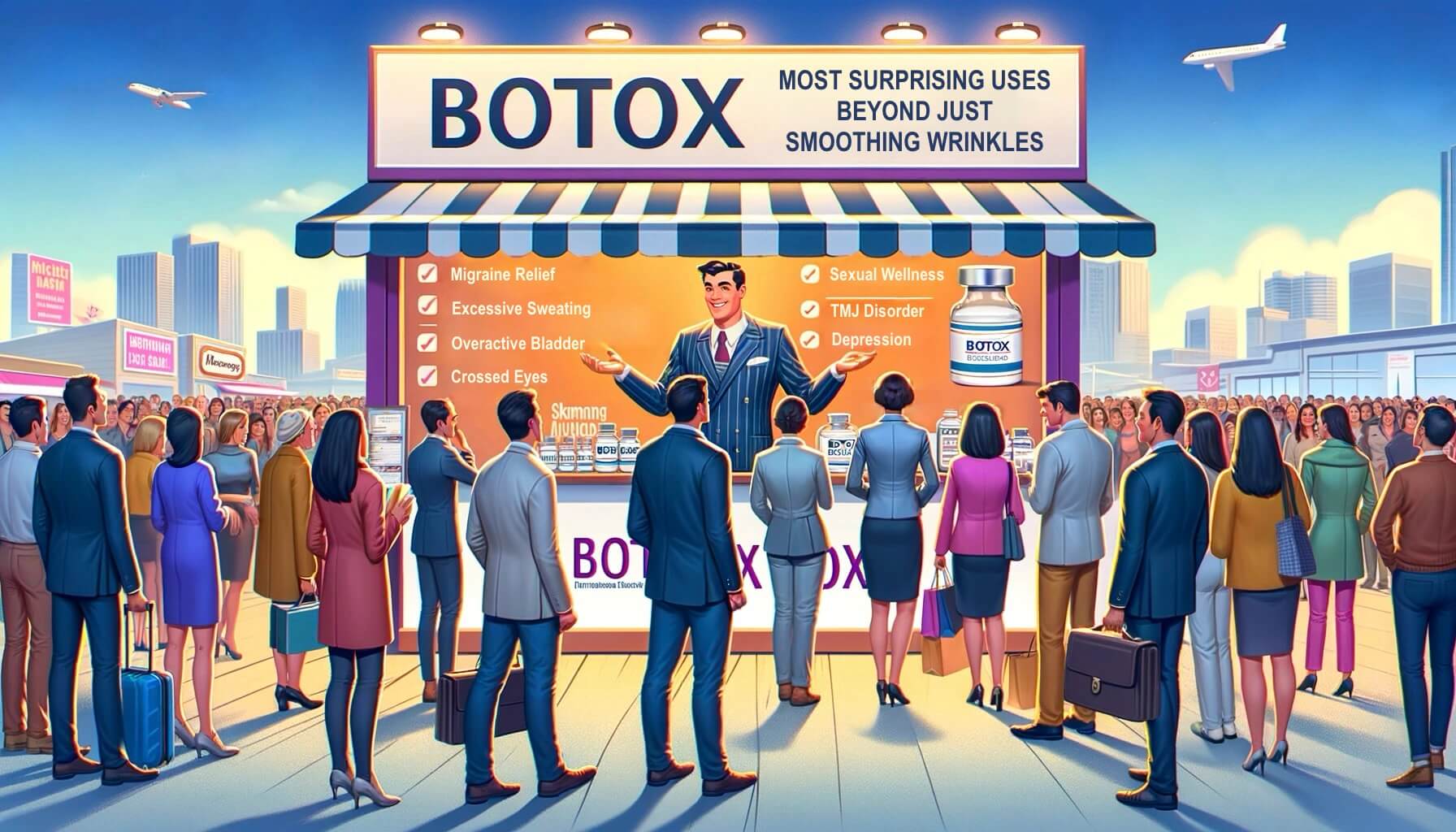
Since its initial FDA approval in the early 2000s for the treatment of frown lines, Botox Cosmetic has become a household name for age-defying and cosmetic beauty. However, Botox, originating from a highly potent natural toxin, has astounded the medical world with its multifaceted utility extending well beyond the realm of wrinkle reduction.
Today, Botox is acclaimed not merely for its aesthetic benefits in creating smoother complexions but also for its extensive therapeutic uses in diverse medical conditions. With regulatory green lights for more than nine medical indications alongside various cosmetic ones, the trajectory of Botox from a potential poison to a therapeutic wonder is truly remarkable. Allergan, the company behind Botox, boasts over 800 patents, indicating the expansive potential this pharmaceutical has in transforming the treatment landscape for ailments such as chronic migraines, hyperhidrosis, back pain, and eyelid spasms.
This article aims to shed light not only on the FDA-approved uses of Botox beyond its cosmetic applications, but also explores its off-label uses, casting a wider lens on the drug's potential.
Botox derived from botulinum toxin type A, is FDA approved for chronic migraine relief and can provide a minimally invasive alternative to medication, lasting three months per treatment.
Beyond cosmetic use, Botox treats various medical conditions such as excessive sweating, overactive bladder, and TMJ disorders, with benefits lasting from six months to a year.
Use of Botox extends to managing conditions like Bell’s palsy, eye twitching, depression, muscle contractures, acne, improving scar appearance, and potentially aiding in hair rejuvenation.
Who would have thought that the same treatment that helps keep our skin wrinkle-free could also provide relief for chronic migraines? FDA approved Botox treatments for chronic migraines were approved in 2010, highlighting the medical world’s recognition of Botox’s potential beyond cosmetic enhancements. These treatments are approved for individuals 18 and older who experience 15 or more migraine days per month.
The way Botox works to treat migraines is by reducing muscle activity and blocking nerve signals responsible for pain. To treat migraines, botulinum toxin is injected into multiple areas around the head and neck by licensed medical professionals. What’s more, the effect of Botox injections for chronic migraines lasts for about three months, making this a minimally invasive alternative to other medications.
If you’re someone who struggles with excessive underarm sweating, you’ll be delighted to know that Botox could be your saving grace. The FDA has approved Botox for the treatment of excessive underarm sweating, with the effects lasting up to six to seven months. Botox injections effectively treat hyperhidrosis by blocking the neurotransmitter that stimulates the sweat glands, leading to a significant reduction in sweating.
Patients receiving Botox for hyperhidrosis can typically expect the treatment effects to begin within two weeks, significantly reducing wetness in the treated areas. Though highly effective, some patients may experience side effects such as pain, swelling, and bruising at the site of the injection.
Another one of Botox’s surprising uses is in controlling overactive bladder symptoms. By calming the nerves responsible for an overactive bladder, Botox can lead to fewer leaks, improving patients’ quality of life. Approximately 70-75% of patients who receive Botox treatment for overactive bladder experience significant symptom reduction.
The procedure involves injecting Botox directly into the bladder muscle through a cystoscope, typically under local anesthesia. The effects of Botox for bladder issues are generally apparent within two weeks and can last from 6 to 12 months. However, Botox injections for overactive bladder are considered after other treatments, such as medications and behavioral therapies, have not been effective.
One of its earliest FDA-approved uses, Botox offers a promising solution for strabismus, commonly known as "crossed eyes" or "misaligned eyes".
By temporarily relaxing the muscles around the eye, Botox can help realign the eyes, potentially improving both vision and appearance for children and adults. This treatment can be particularly appealing as a less invasive and possibly more cost-effective alternative to traditional surgery, especially for those who have not found success with standard interventions.
However, it's important to understand that Botox's effects are temporary, and treatment results vary from one person to another. Repeated sessions may be necessary to maintain eye alignment. For many, Botox represents a valuable option in managing strabismus, offering a blend of efficacy and minimal invasiveness.
Persistent eye twitching, also known as eyelid spasms, can be a real bother, especially for those who also experience crossed eyes. Thankfully, Botox treatments have been shown to effectively treat this condition. Botox is injected into the muscles to disrupt signals causing spasms and help the muscles relax.
The procedure involves using a tiny needle to inject Botox into various areas of the eyelids and brows, avoiding any danger of puncturing the eye. A topical anesthetic may be used to numb the area before the botox injection. The relief generally lasts for three to four months, with subsequent injections needed for maintained benefits.
Botox has also been seen to alleviate TMJ disorders by relaxing the jaw muscles and reducing tension, which can also help in reducing neck and shoulder pains, including shoulder myofascial pain syndrome. Studies have indicated that Botox injections result in a significant reduction of TMJ symptoms such as pain, jaw clicking, and limited mobility.
Botox treatment for TMJ involves:
However, Botox for TMJ disorders is considered an off-label use and costs vary, with some insurance companies covering it under specific conditions.
Bell’s palsy patients, rejoice! Botox has been shown to effectively manage Bell’s palsy symptoms by reducing involuntary muscle contractions and improving facial symmetry. Multiple studies show Botox’s success in managing facial synkinesis and muscle spasms, highlighting onset of symptom improvement within days and lasting for months.
Long-term management with Botox, documented over six years in a case study, exhibited significant pain reduction and improvement in facial symmetry for a Bell’s palsy patient. Combining Botox with other treatments such as facial nerve physical therapy and surgical procedures enhances the management of facial paralysis and symmetry.
Botox can also assist in the battle against acne. It targets the sebaceous glands, reducing their sebum production which can otherwise trap dirt and bacteria leading to breakouts. In addition to reducing oil production, Botox can diminish inflammation and redness associated with acne, and improve the appearance of acne scars.
The forehead is the most common and effective area for using Botox to manage oiliness, though it is not a complete solution and is not as focused on other facial areas. So, if you’re battling acne and have tried other treatments without success, Botox might be worth considering!
For those dealing with muscle contractures, Botox might be your solution. Botox:
Blocks the interaction between nerve and muscle cells, including neck muscles.
Relaxes the targeted muscles by temporarily blocking nerve signals.
Provides relief from spastic muscles and pain.
Enhances gait
Improves range of motion
This treatment is particularly beneficial for children with cerebral palsy, as it can also help alleviate foot pain.
The procedure involves injecting Botox directly into the affected muscle using a tiny needle following dilution with saline. The number of Botox injections for muscle contractures varies depending on the condition treated and the size of the treatment area.

Botox's involvement in sexual health, although less commonly recognized, is capturing interest for its promising advantages in various conditions. It's crucial to highlight that these applications are considered off-label uses, signaling they have not received FDA approval for these specific treatments.
Perhaps one of the most surprising uses for Botox is in the treatment of depression. Clinical trials have shown that a single treatment of botulinum toxin A in the forehead can reduce symptoms of major depressive disorder in over half the subjects, with nearly one-third achieving remission. In fact, botox treats depression quite effectively for many individuals.
has drawn parallels between the antidepressant effects of Botox and sertraline, a common drug for depression, finding Botox can lead to earlier mood improvements and fewer side effects. The mood-enhancing effects of botulinum toxin treatments can last for three to four months, with many patients considering the benefits to be worth the cost.
Another surprising use for Botox is in the reduction of scar visibility. Studies have proven that Botox can effectively improve the appearance of scars, making them narrower, flatter, and generally better looking, especially after reconstructive facial surgery.
Botox contributes to scar reduction by relaxing the muscles around the scar, thus diminishing tension and movement that can otherwise worsen the healing process. For optimal scar healing, Botox should be injected early in the healing process, which may eliminate the need for follow-up sessions during the initial phase of recovery.
Last but not least, Botox can also be used for hair rejuvenation. Botulinum toxin injections when applied to the scalp can address concerns related to excessive sweating, allowing individuals to extend the time between hair washes and maintain a cleaner hair appearance.
The injections can relax scalp muscles, potentially enhancing hair growth by allowing more nutrients to reach the hair follicles, and aid in keeping the hairline sweat-free to prolong the look of a fresh hairstyle. However, while this application of Botox is promising, it remains under-researched and might not be effective for completely bald areas.
In conclusion, Botox's applications surpass its famed wrinkle-erasing effects, offering versatile treatments for conditions like migraine, excessive sweating, overactive bladder, and even depression relief. This wide range of uses highlights Botox's significant potential to improve ones quality of life. With ongoing research paving the way for new applications, Botox emerges not just as a cosmetic solution but as a substantial aid in addressing various health concerns. If you're grappling with any of the conditions mentioned, considering Botox could be a step toward both aesthetic improvement and substantial health benefits.

Dr. Alonso Martin is a renowned physician at the intersection of science, beauty, and longevity. Beginning his career at UCLA as a neuroscientist studying antioxidants' effects on longevity, Dr. Martin now leads AM Beauty & Wellness Medspa in Miami, specializing in the latest non-invasive facial and body rejuvenation techniques. His expertise spans cosmetic dermatology, focusing on injectable neuromodulators like Botox, Daxxify, Dysport, and Xeomin, alongside an array of fillers including RHA, Juvederm, and Sculptra, to name a few. He is also adept in natural skin rejuvenation through PRF (Platelet-Rich Fibrin), stimulating collagen production and mitigating signs of aging.
Further enhancing his practice's offerings, Dr. Martin utilizes Emsculpt NEO technology for muscle growth, tissue lifting, and fat elimination—techniques favored by NFL athletes and celebrities for strength and longevity. He passionately advocates for strengthening the body and optimizing its function as an anti-aging solution, incorporating peptide therapy to support overall wellness.
Dr. Martin trained at the University of California, Irvine Hospital in family medicine, where he treated patients of all ages with obesity, diabetes, thyroid & hormone disorders, high blood pressure, age-related diseases, chronic pain, and autoimmune conditions. With prestigious nominations like Resident of the Year at UCLA, he holds an M.D. from Michigan State University and a B.Sc. in Neuroscience from UCLA. Licensed in both Florida and California, Dr. Martin's credentials underscore his commitment to enhancing patient well-being through advanced medical practices.
If you have any questions or would like to schedule an appointment, contact AM Beauty & Wellness today by calling (305) 877-5084.
Schedule Your Consultation Today
The future looks brighter when you feel better. Dr. Alonso Martin and his team want to give you the joy of a longer, healthier life. Schedule your consultation today to learn how the right blend of anti-aging and nutrional intervention can help you improve your quality of life for years to come.
1060 Alton Rd, Miami Beach, FL 33139
Book directly online by following these easy steps
Or fill out this form to receive more information